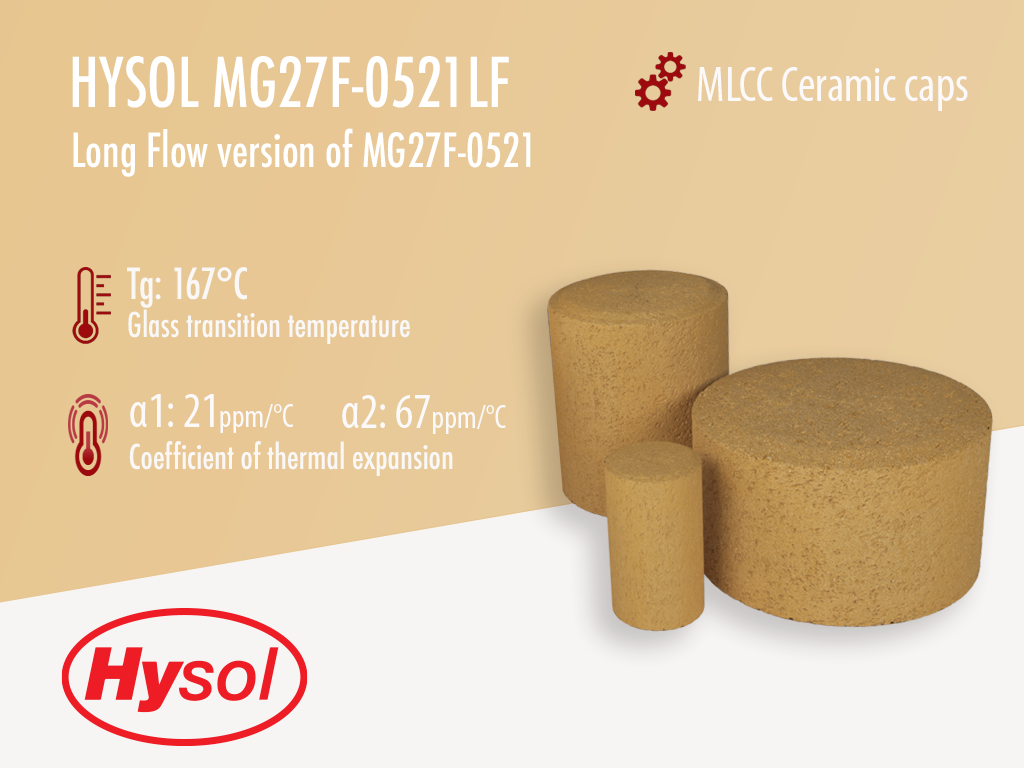Hysol MG27F-0521LF | Gold Epoxy Mold Compound
Harmonization Code : 3907.30.00.90 | Polyacetals, other polyethers and epoxide resins, in primary forms; polycarbonates, alkyd resins, polyallyl esters and other polyesters, in primary forms : Epoxide resins : Other
Main features
- UL listed file number E255557
- Long Flow version of MG27F-0521
- Used for ceramic capacitors
Product Description
Hysol MG27F-0521 LF is a specially formulated Gold, laser markable product designed for use in high volume molding of multi-layer ceramic capacitors (MLCC). MG27F-0521 LF was developed to provide optimum moldability in conventional transfer molding applications. It features good moisture resistance and low ionics. Its gold color provides excellent contrast in lasermark applications.
Hysol MG27F-0521 LF is listed under the UL file number E255557. It is a UL listed product for Multi Layer Ceramic Capacitors (MLCC). The entire list of UL-listed products can be found at the Hysol UL-listed Epoxy Molding compounds
Hysol MG27F-0521LF is designed for the following semiconductor packages:
- Multi-Layer Ceramic Capacitors
- Cermaic Resistors
- Other passive electronics components
Technical Specifications
| General Properties | |||||||||||
| Color Color The color | Gold | ||||||||||
| Specific Gravity Specific Gravity Specific gravity (SG) is the ratio of the density of a substance to the density of a reference substance; equivalently, it is the ratio of the mass of a substance to the mass of a reference substance for the same given volume. For liquids, the reference substance is almost always water (1), while for gases, it is air (1.18) at room temperature. Specific gravity is unitless. | 1.91 | ||||||||||
| |||||||||||
| Physical Properties | |||||||||||
| Spiral Flow @ 175°C | 63 cm | ||||||||||
| Chemical Properties | |||||||||||
| |||||||||||
| Electrical Properties | |||||||||||
| |||||||||||
| Volume Resistivity Volume Resistivity Volume resistivity, also called volume resistance, bulk resistance or bulk resistivity is a thickness dependent measurement of the resistivity of a material perpendicular to the plane of the surface. | 8.9x1016 Ohms⋅cm | ||||||||||
| Mechanical Properties | |||||||||||
| |||||||||||
| |||||||||||
| |||||||||||
| Molded Shrinkage | 0.4 % | ||||||||||
| |||||||||||
| Thermal Properties | |||||||||||
| |||||||||||
| |||||||||||
| Glass Transition Temperature (Tg) Glass Transition Temperature (Tg) The glass transition temperature for organic adhesives is a temperature region where the polymers change from glassy and brittle to soft and rubbery. Increasing the temperature further continues the softening process as the viscosity drops too. Temperatures between the glass transition temperature and below the decomposition point of the adhesive are the best region for bonding. The glass-transition temperature Tg of a material characterizes the range of temperatures over which this glass transition occurs. | 167 °C | ||||||||||
| Thermal Conductivity Thermal Conductivity Thermal conductivity describes the ability of a material to conduct heat. It is required by power packages in order to dissipate heat and maintain stable electrical performance. Thermal conductivity units are [W/(m K)] in the SI system and [Btu/(hr ft °F)] in the Imperial system. | 0.65 W/m.K | ||||||||||
| UL 94 Rating UL 94 Rating Flammability rating classification. It determines how fast a material burns or extinguishes once it is ignited. HB: slow burning on a horizontal specimen; burning rate less than 76 mm/min for thickness less than 3 mm or burning stops before 100 mm V-2: burning stops within 30 seconds on a vertical specimen; drips of flaming particles are allowed. V-1: burning stops within 30 seconds on a vertical specimen; drips of particles allowed as long as they are not inflamed. V-0: burning stops within 10 seconds on a vertical specimen; drips of particles allowed as long as they are not inflamed. 5VB: burning stops within 60 seconds on a vertical specimen; no drips allowed; plaque specimens may develop a hole. 5VA: burning stops within 60 seconds on a vertical specimen; no drips allowed; plaque specimens may not develop a hole | V0 | ||||||||||
| Curing Conditions | |||||||||||
| |||||||||||
| |||||||||||
| Transfer Pressure | 35 - 105 kg/cm2 | ||||||||||
| Transfer Time | 12 - 25 s | ||||||||||




